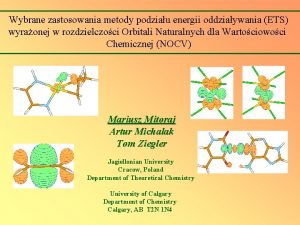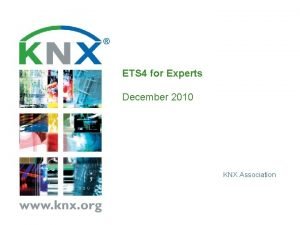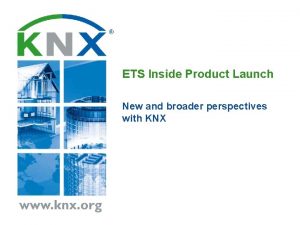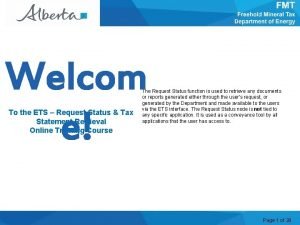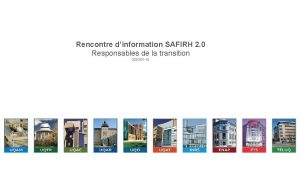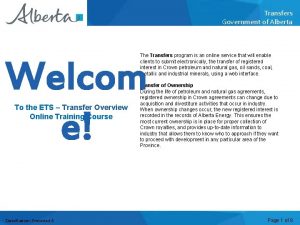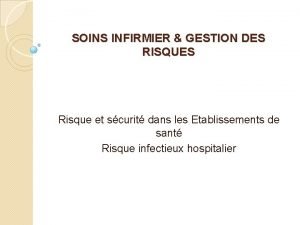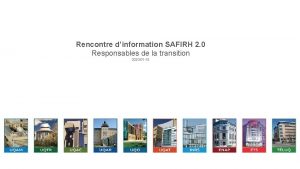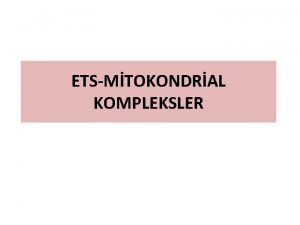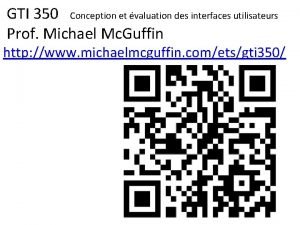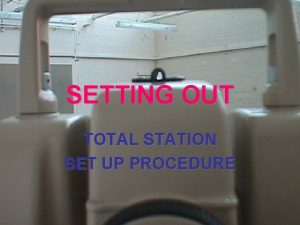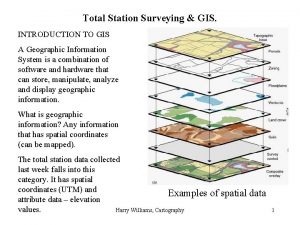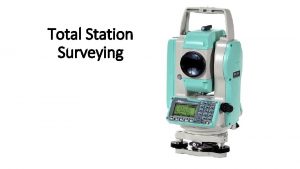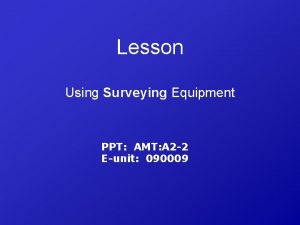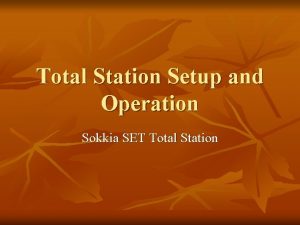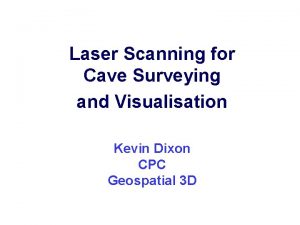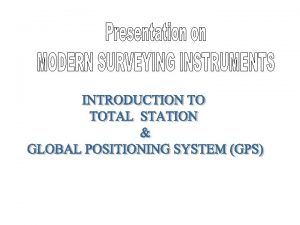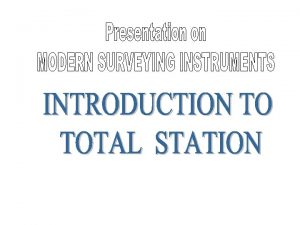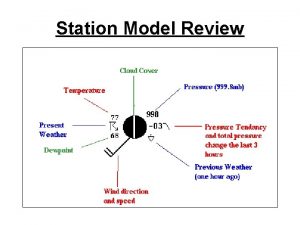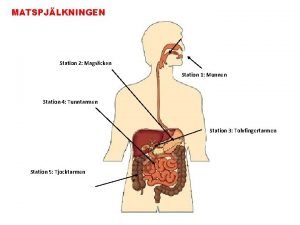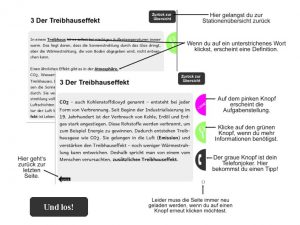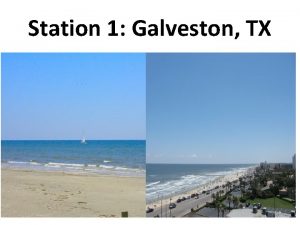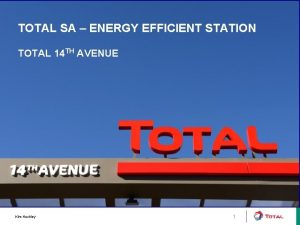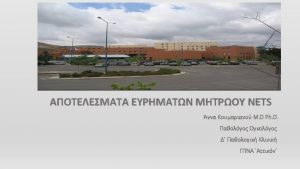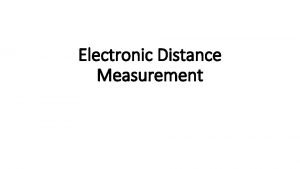Electronic Total Station ETS Electronic Total Station The















































- Slides: 47


Electronic Total Station (ETS)

Electronic Total Station The Total Stations are recent and most common types of electronic surveying instruments comprising of mainly an EDM, an EDT and a limited capability micro processor in a single compact and mobile unit which can be setup on tripod at field during survey to collect essential distance - direction data to define the positions of points with respect to each other.

What Is Total Station • COMBINATION OF EDT + EDM + Computer • ON BOARD MEMORY SYSTEM INCLUDING DOWNLOAD & UPLOAD FACILITY • IN BUILT PROGRAMME FOR CO-ORDINATE CALCULATION, AREA CALCULATION, STAKE-OUT etc.

Principal Features Of ETS • • Measures Direction & Distance Simultaneously Effortless Levelling Through Electronic Digital Bubble Effortless Centering Through Laser Plummet Automatic Correction For Temperature, Pressure, Curvature and Refraction Multi Axis Compensator Data Storage Facility Data Downloading and Uploading Facility On Board Computer

Principal Features • Effortless Levelling Through Electronic Digital Bubble • Automatic Correction For i) Temperature ii) Pressure iii) Curvature

WATER AND DUST RESISTANT The rain cannot come into the inside of the instrument in unexpected rainfall and it is specially designed for the bad site conditions the machine is completely dustproof

LUMI GUIDE OPERATION

REFLECTORLESS MEASUREMENT REMOTE CONTROL SYSTEM WITH THIS FEATURE YOU CAN DETERMINE POINTS AND MEASURE DISTANCES WITHOUT USEING ANY REFLECTOR.

TRI-AXIAL COMPENSATOR Tri axis compensator performs fine leveling and error which occurs where the vertical and horizontal axis intersect

AUTOMATIC ATMOSPHERE SENSOR The built in automatic atmospheric sensors, measures the temperature and pressure in real time, and initiates ppm correction. thus, the user no longer needs to bother with inputting these data

LASER PLUMMET The machine enables easy to center over a setup point thanks to the laser plummet. The intensity of the laser point can be adjusted step-by-step to maintain visibility even in critical lighting conditions

MEASUREMENT OF DISTANCES, DIRECTIONS AND ELEVATION

Basic Common Inbuilt Programmes 1. 2. 3. 4. 5. 6. 7. 8. Reduction of co-ordinates Area & Perimeter Calculation Remote Elevation Measurement Missing Line Measurements Offset Measurements Resection COGO (Co-ordinate Geometry) Setting Out

CARTESION & POLAR FRAME Of REFERANCE CARTESION Easting of p = r * Sin q Northing of p = r * Cos q POLAR p= rq

AREA MEASURMENT Area In sq. Mtr. And Hector

REMOTE ELEVATION MEASURMENT ent

Co-ordinate Geometry Line – Line Intersection Line – Circle Intersection Circle – Circle Intersection Reference Line Calculation Bearing & Distance Point & Point

SETTING OUT

ADVANTAGES OF USING TOTAL STATION • ACURACY IN DISTANCE MEASURMENTS AND ANGLE MEASURMENTS • ELIMINATION OF MANUAL ERRORS • ELIMINATION OF MATHEMATICAL CALCULATION • GENERATION OF DATA IN DIGITAL FORMAT • ZERO PLOTTABLE ERROR • REDUCTION OF TIME AND COST • PROFESSIONAL OUTPUT AND QUALITY PRODUCT

NETWORK Total Station Survey Downloading Field Sketches Cad Drafting Digitisation of Records Superimposition Multi size and Multicolour Tracing / Paper output Digital Output Reports

DXF DATA RECEIVED FROM TOTAL STATION

DOWNLOADED DATA ALONGWITH DESCRIPTION AND POINT NUMBERS

PROCESSING OF DATA AND VECTERISATION USING AUTO-CAD SOFTWARE

DEVELOPMENT OF CO-ORDINATE SYSTEM ARBITARY CO-ORDINATES N-1000 , E-1000 TAKEN AT TRAVERSE STATION NO. 1

FINAL OUTPUT INITIAL RAW DATA

GPS

Global Positioning System (GPS)

What is GPS? GPS is a space based all weather radio navigation system.

GPS Provides Position (geographic), Velocity & Time (PVT) Quickly, Economically And Precisely 24 hours a day, anywhere in the world under the sky

GPS Consists of Three Segments

Salient steps 1. The receiver picks up the signals from the satellites; 2. Uses signal travel time to calculate distance to the satellites 3. Using Analytical Principle, position of the receiver gets calculated.

Space Segment Constellation of 24 navigational satellites. Four satellites are placed in each of six orbital planes with an inclination of about 55° to the equator. With this constellation 4 to 10 GPS satellites are always available above the horizon anywhere in the world.

Space segment § 24 satellites § Orbit every 12 hours at 20, 200 kms § 4 satellites in each of 6 orbital planes § Transmit a uniquely coded radio signal § Equipped with onboard atomic standard

What is so special about an 20200 km orbit? • ‘Orbits’ twice per day • Large ‘viewable’ area

Control segment Worldwide network of tracking stations, with a master control station located in United States. The primary task of the control segment is to track GPS satellites in order to determine and predict some information and upload into the GPS satellite

Control segment § Ground-based monitoring and upload stations § Control orbit and timing information

USER It includes all GPS users. User can receive the GPS signals through antenna connected to the receiver and can determine its position on the surface of the earth

User segment § GPS Receivers; § Compatible software for Planning, Downloading and Processing of GPS receiver data;

GPS Receivers (contd. ) Navigation § capable of about 12 meter accuracy § light-weight, cheap! § navigation applications

Different modes of GPS positioning Point positioning It involves only one GPS receiver that simultaneously receives signals from at least four satellites to determine its own co-ordinates with respect to the center of the earth.

Differential positioning It is a relative positioning which involves two receivers, one called as a base and the other called as a rover, simultaneously tracking the same satellites to determine their relative co-ordinates. The base whose co-ordinates are known precisely remains stationary at a site and the rover may or may not be stationary

S 2(x 2, y 2, z 2) S 1(x 1, y 1, z 1) S 3(x 3, y 3, z 3) GPS Receiver (X, Y, Z) 1 = {(x 1 -x)2+(y 1 -y)2+(z 1 -z)2} + c. Δt 2 = {(x 2 -x)2+(y 2 -y)2+(z 2 -z)2} + c. Δt 3 = {(x 3 -x)2+(y 3 -y)2+(z 3 -z)2} + c. Δt 4 = {(x 4 -x)2+(y 4 -y)2+(z 4 -z)2} + c. Δt Principle of GPS Positioning S 4(x 4, y 4, z 4)

60 Zones and 20 Latitude Bands 1 Latitude Bands 84º N 80º S X W V U T S R Q P N M L K J H G F E D C Zones 60 43 Equator 43 P

GPS is getting popular as a means for collection of data GPS DATA • Reliable • Accurate • Real-time

Some Applications of GPS

GPS Can be used in any conceivable situation Under the sky Where the exact position of any object or phenomena involved. Thanks
 An electronic is the electronic exchange of money or scrip
An electronic is the electronic exchange of money or scrip Electronic field production examples
Electronic field production examples Ets
Ets Ets-nocv
Ets-nocv Kemosentetik bakteriler
Kemosentetik bakteriler Tricomoniasis fotos. reales
Tricomoniasis fotos. reales Phlebotomy supplies and equipment
Phlebotomy supplies and equipment Oksijenli solunumda son elektron tutucu
Oksijenli solunumda son elektron tutucu Alcohol consumption causes blood vessels to contract
Alcohol consumption causes blood vessels to contract Tofel ets
Tofel ets Eu-ets 가격
Eu-ets 가격 Mytoms ets
Mytoms ets Criterion.ets.org
Criterion.ets.org Ets 4
Ets 4 Ets inside server
Ets inside server Ets cycle diagram
Ets cycle diagram Ets status
Ets status Ets
Ets Safirh poly
Safirh poly Alberta energy ets
Alberta energy ets Infection nosocomiale
Infection nosocomiale Safirh enap
Safirh enap Ets kompleksleri
Ets kompleksleri Ets vision
Ets vision Ets mihajlo pupin novi sad
Ets mihajlo pupin novi sad Ets
Ets Gti350
Gti350 Pro ethica
Pro ethica Http //pisa.ets.org/school questionnaire
Http //pisa.ets.org/school questionnaire Ets success navigator
Ets success navigator Ets
Ets Tricomoniasis fotos
Tricomoniasis fotos Mitokondri atp sentezi
Mitokondri atp sentezi Setting up a total station
Setting up a total station Gis total station
Gis total station Total station basics
Total station basics Chain surveying ppt
Chain surveying ppt Leica total station setup and operation
Leica total station setup and operation Total station visualisation
Total station visualisation Vẽ hình chiếu vuông góc của vật thể sau
Vẽ hình chiếu vuông góc của vật thể sau V cc
V cc Làm thế nào để 102-1=99
Làm thế nào để 102-1=99 Hát lên người ơi alleluia
Hát lên người ơi alleluia Tỉ lệ cơ thể trẻ em
Tỉ lệ cơ thể trẻ em Lời thề hippocrates
Lời thề hippocrates Sự nuôi và dạy con của hổ
Sự nuôi và dạy con của hổ đại từ thay thế
đại từ thay thế Quá trình desamine hóa có thể tạo ra
Quá trình desamine hóa có thể tạo ra



